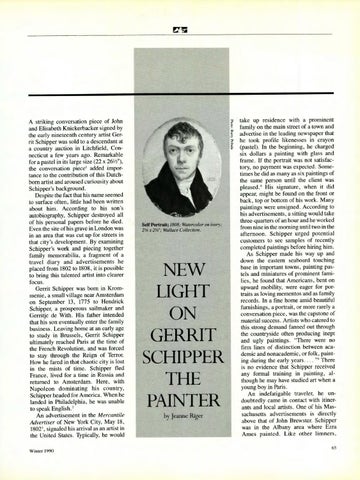110
A striking conversation piece of John and Elisabeth Knickerbacker signed by the early nineteenth century artist Gerrit Schipper was sold to a descendant at a country auction in Litchfield, Connecticut a few years ago. Remarkable 2"), 1 for a pastel in its large size(22 x 26/ the conversation piece' added importance to the contribution of this Dutchborn artist and aroused curiousity about Schipper's background. Despite the fact that his name seemed to surface often, little had been written about him. According to his son's autobiography, Schipper destroyed all of his personal papers before he died. Even the site of his grave in London was in an area that was cut up for streets in that city's development. By examining Schipper's work and piecing together family memorabilia, a fragment of a travel diary and advertisements he placed from 1802 to 1808, it is possible to bring this talented artist into clearer focus. Gerrit Schipper was born in Krommenie, a small village near Amsterdam on September 13, 1775 to Hendrick Schipper, a prosperous sailmaker and Gerritje de With. His father intended that his son eventually enter the family business. Leaving home at an early age to study in Brussels, Gerrit Schipper ultimately reached Paris at the time of the French Revolution, and was forced to stay through the Reign of Terror. How he fared in that chaotic city is lost in the mists of time. Schipper fled France, lived for a time in Russia and returned to Amsterdam. Here, with Napoleon dominating his country, Schipper headed for America. When he landed in Philadelphia, he was unable to speak English.' An advertisement in the Mercantile Advertiser of New York City, May 18, 18023,signaled his arrival as an artist in the United States. Typically, he would Winter 1990
Self Portrait; 1808; Watercolor on ivory; 25/e x 2W; Wallace Collection.
NEW LIGHT ON GERRIT SCHIPPER THE PAINTER by Jeanne Riger
take up residence with a prominent family on the main street of a town and advertise in the leading newspaper that he took profile likenesses in crayon (pastel). In the beginning, he charged six dollars a painting with glass and frame. If the portrait was not satisfactory, no payment was expected. Sometimes he did as many as six paintings of the same person until the client was pleased.' His signature, when it did appear, might be found on the front or back, top or bottom of his work. Many paintings were unsigned. According to his advertisements, a sitting would take three-quarters of an hour and he worked from nine in the morning until two in the afternoon. Schipper urged potential customers to see samples of recently completed paintings before hiring him. As Schipper made his way up and down the eastern seaboard touching base in important towns, painting pastels and miniatures of prominent families, he found that Americans, bent on upward mobility, were eager for portraits as loving mementos and as family records. In a fine home amid beautiful furnishings, a portrait, or more rarely a conversation piece, was the capstone of material success. Artists who catered to this strong demand fanned out through the countryside often producing inept and ugly paintings. "There were no firm lines of distinction between academic and nonacademic,or folk, painting during the early years....'" There is no evidence that Schipper received any formal training in painting, although he may have studied art when a young boy in Paris. An indefatigable traveler, he undoubtedly came in contact with itinerants and local artists. One of his Massachusetts advertisements is directly above that of John Brewster. Schipper was in the Albany area where Ezra Ames painted. Like other limners, 65
